Emma Triggs on how Van Gogh Alive revived the arts in desperate times
When the entertainment industry ground to a halt, Emma Triggs sprung into action, bringing a visual masterpiece to Sydney that revived the arts scene in desperate times.
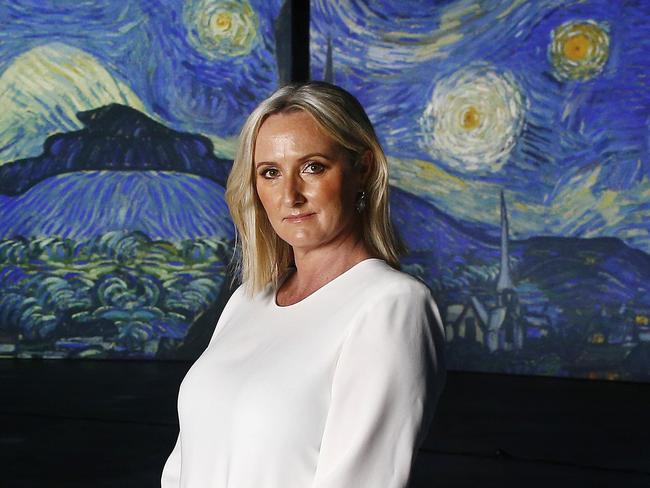
Mosman
Don't miss out on the headlines from Mosman. Followed categories will be added to My News.
Friday the 13th, March 2020. Emma Triggs’ bad luck had only just begun. With the NSW Government announcing the immediate halt of all major live events because of COVID-19, the team at her successful production and marketing agency set about cancelling every project on their books.
“The entertainment sector generally thrives in difficult times but not with COVID,” says Emma. “I remember that Friday. It killed the business.”
Sitting at a small table in a pop-up cafe inside the Royal Hall of Industries, Moore Park, Emma straightens a chequered plastic tablecloth for the third time. Classical music seeps through the nearby ceiling-high walls enclosing her new venture, Van Gogh Alive. More than seven months after that black Friday, she has a hit on her hands. Specifically, a multisensory hit where 40 high definition projectors beam the Dutch artist’s works onto large screens, sections of the paintings are animated with motion graphics, surround sound speakers boom music synchronised with the displays, and the fragrances of the South of France – cypress, lemon, cedar – float by. Admittedly, the compulsory masks policy limits the impact of the fine scents.
Originally planned as a limited season starting in September, the exhibition tickets quickly sold out, prompting Emma to extend the run until 20 December.
Recalling the dark days earlier this year, Emma is straight-backed, unsmiling. “Our work stopped. We had to close the Melbourne office. I had two options: sit it out which meant waiting until the money ran out or find something new to invest in.”
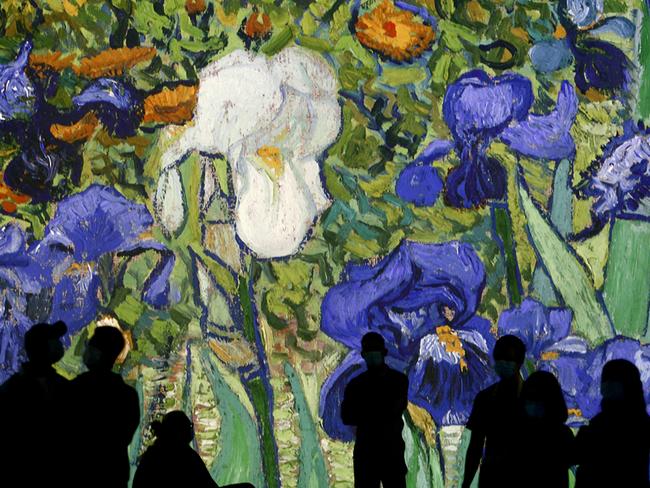
She investigated local ideas. “A bakery. After all, my grandfather sold his bakery to Tip Top and he did quite well out of that.” And international ones. Previously she’d seen the work of Melbourne-based Bruce Peterson who specialises in “unique exhibition experiences”. Having developed the Van Gogh Alive concept and put it on in 50 cities around the world with six million visitors, Bruce was planning to stage it in Melbourne. COVID-19 blocked that plan.
Despite the pandemic, Emma offered to produce it in Sydney: “It was a really big risk but I had to find a way to utilise the skills of my team at the M Agency.”
Any doubts? “We tried to get government support through Arts grants but we didn’t qualify. When I was signing off on the project and the numbers were increasing, I thought I can’t delay because if I don’t do this, I’ve got nothing.”
Remembering initial reactions to her plans to stage Van Gogh Alive, Emma gives a laugh. “I certainly got a few strange looks. My idea was going against the grain of what was happening in the world because all the event companies were closing down, not pivoting towards more productions.”
Her research revealed museums and galleries were reopening first because they were a “no touch” experience and organisers could control the number of people moving through a large venue with no seating.
The stately former Showbag Pavilion is certainly that. Built in 1913 with a vaulted ceiling, the Royal Hall of Industries comfortably holds this new exhibition for the digital age. Being digital was key for Bruce Peterson. The catalyst for his business Grande Exhibitions was his children’s boredom with traditional ways of presenting the Arts. He says that during visits to some of the world’ great museums and galleries “five or 10 minutes into those experiences my young kids were tapping me on the shoulder saying ‘Dad, this is boring. Let’s go get a gelato.’ I really couldn’t quite work out at the time why it wasn’t interesting.”
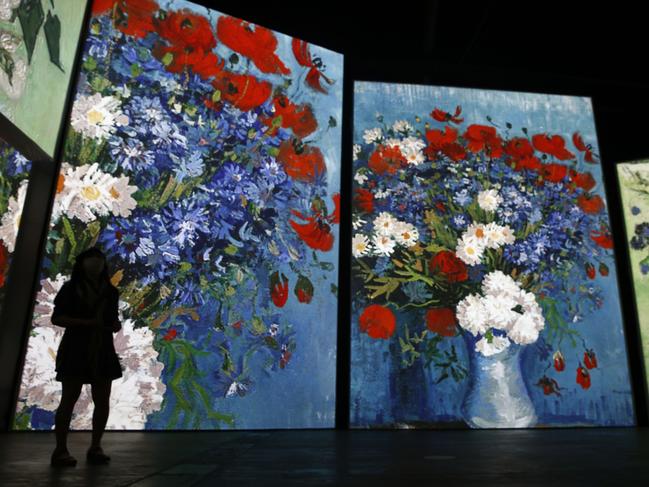
Then watching his children engage with electronic devices prompted him to spend two years developing multimedia events which have segued into multisensory ones. “We’re linking the human senses together and synchronising them. Now, you as the visitor will get a more emotional outcome and a more amplified one.”
Emotional is the word. “We’ve had a few people leave in tears,” says Emma. “It’s been such a traumatic year and people turn to the Arts in tough times, but there’s been no big events on. People have been stuck at home with their computers, devices and television screens. This is an opportunity to get out and see something beautiful, something that’s well produced that actually stirs emotions.
“When visitors walk into the space, lots of them are really quiet in there. You can see the ‘wow’ look on their faces. The experience can also be really serene. It’s quite overwhelming and, of course, there’s the soundtrack which is just so gorgeous.”
Not all reactions are the same. The adults often stand quietly in the event space, seemingly entranced by the sharply-defined imagery and the droll takes on Van Gogh’s works – a steam train chugs through the countryside, cherry blossoms cascade, the Paris skyline is in motion, and crows suddenly sweep above a farmer’s field. Meanwhile, children try to jump on animated pages from Van Gogh’s diaries as the images scoot across the floor.
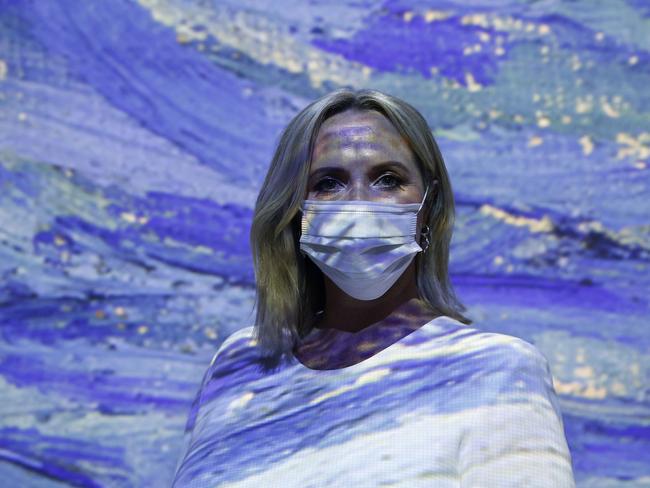
On a recent weekday, visitor Yana Grimko’s young daughter Dasha danced to the music while Yana, from Pyrmont, gazed around, impressed by the entire event. “Amazing. There are good insights into Van Gogh’s psyche and, although I knew his art, I learnt a lot of about the man that I didn’t know before.”
Online comments about the exhibition are equally effusive. Stavroula Nicholls wrote: “It was magical. It was so immersive.” “Exciting, innovative and beautiful,” noted Anita Fernandes.
Emma Triggs says visitors have been moved by extracts from the artist’s letters to his brother Theo. “The letters are so relevant today and they’re prompting a lot of emotion. Vincent van Gogh had a difficult life, he lived in a difficult time and he was lonely. It’s something we can all relate to.”
As the producer, Emma is particularly proud of the broader impact of the project. “So many people have been re-employed because of this event. We have flight attendants who’d lost their jobs and who are now welcoming visitors to the venue and helping them with our COVID precautions.
“I also assembled a dream team to manage the artistic direction and production side including a number of experts who had been stood down from Cirque du Soleil. We’ve custom made the production for this specific venue.
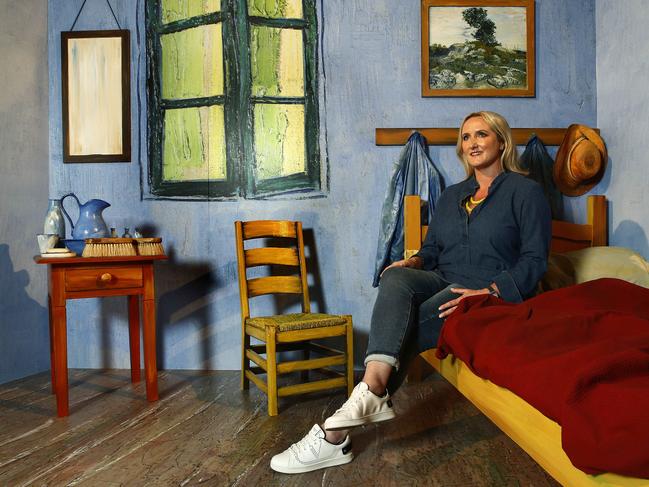
“Then there’s the opportunity to provide work for the crew, the cleaners, the security people … it’s such a positive thing to do. Plus, there’s the reopening of the venue which had been closed because the Sydney Swans surrendered their lease and weren’t able to develop this space as their headquarters.”
Before setting up the M Agency in 1999, Emma was a director at Sony Music, working on major touring acts including Michael Jackson, Celine Dion, Pearl Jam and Tina Arena. The thrust of her own agency is mainly marketing, with clients such as the world’s largest live entertainment company, Live Nation, and Cirque du Soleil.
Emma says she hopes the success of the Van Gogh venture will give confidence to Sydneysiders to return to events, and for promoters and producers to keep investing and not to give up. “There is the biggest pent-up demand I’ve ever seen.”
On the touchy subject of how to pronounce the artist’s surname, Emma is diplomatic. “I started by pronouncing it ‘go’ but my mother Margaret told me off and said it was ‘goff’. Then my husband chipped in with a guttural Dutch pronunciation rhyming with ‘loch’. But I think ‘goff’ is safest for me rather than a dodgy version of the Dutch way of saying Vincent’s name.”
A fourth-generation Mosman resident, Emma and music producer husband Rob Milton live in Beauty Point. Growing up in the area, she lived in the Pindari Avenue house where Sydney’s infamous “granny killer” murdered his last victim in 1990. Emma’s family had sold the property prior to the attack. The house has since been demolished and a new home built on the site.
“There was a history of bad luck in that house,” she says. “I’m so glad the new owners have built a beautiful home there. But in Rob’s and my house, we’ve had such luck and now Van Gogh Alive is part of it.”
Van Gogh Alive is being staged at the Royal Hall of Industries, 1 Driver Ave, Moore Park. Season closes 20 December 2020.
